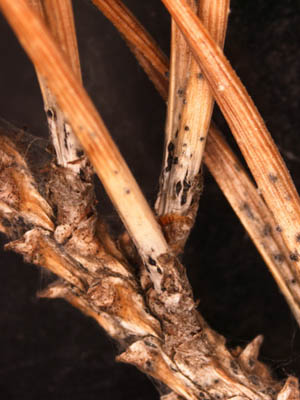Diplodia of Pine Prevalent | |
|---|---|
| August 7, 2008 | |
|
Diplodia tip blight is prevalent in much of Illinois this summer. Take a look around your town, and you likely will see many pines with brown needles at the tips of branches. Entire needles are brown, not just tips of needles as might occur with scorch, salt injury, or transplant shock. Look more closely at the needles, and you may see fungal fruiting bodies, as seen in this picture. When you see dead needles at the tips of pine stems and find the fruiting bodies on the dead needles, a positive Diplodia diagnosis is likely. In the lab, we like to take things one step further. We rarely make a disease diagnosis without seeing the spores of the pathogen causing the disease. We use a razor blade to remove a few of these fruiting bodies, then place them on a microscope slide, add a cover slip, and observe them with a compound microscope. When Diplodia is present, we see the spores flowing out of the fruiting bodies, as in the second image  Several practices can help reduce the amount of damage caused by this disease. When the foliage is dry, remove dead branches and dead stem tips. Because the fungus survives on cones, rake and remove fallen cones throughout the season. Drought-stressed pines have been shown to be more susceptible to infection, so water roots of stressed pines in periods of drought. Chemical options are available, but sprays this late in the season are not beneficial. More information is provided on chemical controls in issue no. 3 of this newsletter. | |
| Author: | Nancy Pataky |

